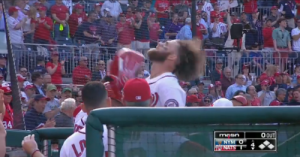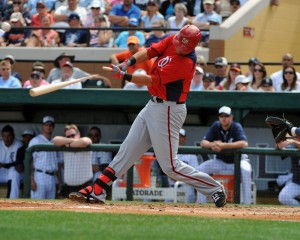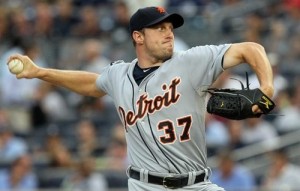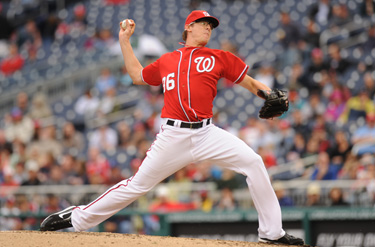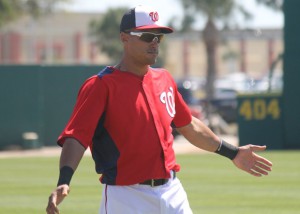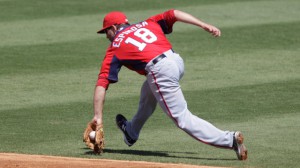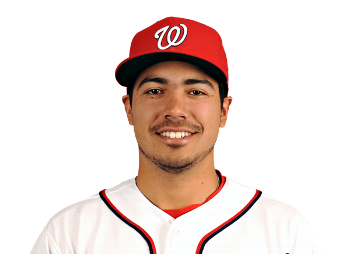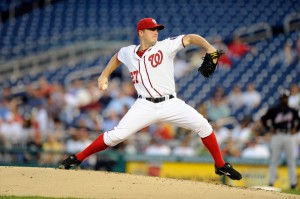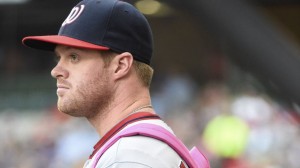- Catchers: Spencer Kieboom, Steven Lerud, Pedro Severino
Discussion: Lerud was a MLFA signing from Atlanta and seems likely to join recently acquired Dan Butler as the primary minor league catching depth for this team. Thanks to an options crunch, Jhonatan Solano has already been released (and signed naturally with Miami to join his brother) and Sandy Leon likely gets DFA’d at the end of spring training, meaning that the Nats AAA depth needs to be rebuilt. Meanwhile Keiboom and Severino represent some of the rising catcher talent in the system that may be in a position to really contribute once our two presumed MLB catchers (Ramos and Lobaton) have reached free agency. The fact is that teams need tons of catchers in spring training camp and it is not surprising to see non 40-man guys get the call to help out with bullpen sessions and then get cut loose once the active camp has been thinned.
Odds of any of these NRIs making the 25-man roster: none for any of these players, even with an injury. Lerud likely sticks around as AAA depth, and Keiboom/Severino have yet to reach rule-5 eligibility.
Future plans: Lerud to AAA and probably out of the org after this season, and the two prospects moving on up the chain (Severino likely in AA and Kieboom in high-A).
- Left Handed Relievers: Matthew Purke
Discussion:I am no longer considering Purke a starter; I think his best shot at making it is if he converts to relief. I’d be ecstatic if he regained his mojo as a starter but i’ve lost confidence as such. That being said; we’re all well enough familiar with Mr. Purke by now: for a couple of days in November I thought we had cut him loose completely, ending a rather expensive Nationals experience. But he re-signed as a MLFA with the team (likely in a pre-arranged deal) and then took the invite to spring training. I’m guessing the senior team officials want to get a look at him, see how he fares as a match up reliever, see if his stuff holds up in short stints, etc. By having Purke in spring training, the senior decision makers can watch multiple bullpen sessions, get a sense of his makeup and drive, and make a decision on his future (see next).
(tangent: fun fact here; did you know that Purke was born in the same town (Nacogdoches, TX) as USMNT striker Clint Dempsey?)
Odds of making the 25-man roster: none. The team didn’t go to all this trouble to get Purke *off* the 40-man roster just to put him back on; there’s other lefty alternatives that will get the first crack at the majors if our standing lefties (Thornton and Blevins) falter. Namely Xavier Cedeno and Matt Grace. Even after the season begins, I could see the team experimenting with Sammy Solis or Felipe Rivero as a reliever in the majors before looking at Purke. Which leads us to Purke’s future plans…
Future plans: Getting Purke back on a non-40-man deal gives Purke a stay of execution. I think the team sees how he does this year and then considers whether to add him back to the 40-man as a protectionary move prior to next off-season. But he can’t be putting up 8+ ERAs in AA. He needs to get guys out or he’s done.
- Right Handed Starters: Bruce Billings, Mitch Lively, Scott McGregor
Discussion: Both Lively and McGregor were signed midway through 2014 after getting dropped by their respective AAA clubs (affiliates of San Francisco and St. Louis respectively), and then each served as essentially an innings eating starter for Syracuse or Harrisburg the rest of the way through. Thanks to a slew of last minute moves, both guys got AAA playoff starts in 2014 as well, neither pitching especially effectively as Syracuse was swept out of the playoffs. Both chose to re-sign in Washington and both will get spring training invites. Billings was signed from Los Angeles in November and was a starter for their AAA affiliate in 2014.
Odds of making the 25-man roster: none. Assuming there are no trades or injuries, the 6th-10th guys in line to get MLB starts likely goes Tanner Roark, Blake Treinen, Taylor Jordan, Taylor Hill and newly-added 40-man member (and long time Nats prospect) A.J. Cole. The Nats used just 8 starters in 2014, so the chances of all 10 of these guys even getting looks seems rather slim right now.
Future plans: You also have to think that the last 4 of these 5 guys will form the bulk of the Syracuse rotation to start 2015, leaving just one slot available. And if it were up to me, I’d have Felipe Rivero in that 5th slot. So its kind of hard to even see where these three guys fit in for 2015, unless they’re heading for long-man duty or are dropping down to AA. I havn’t done enough analysis to even guess what AA’s rotation may look like to see if that’s an option. So perhaps all three guys are playing for other teams’ scouts and for AAA rotations that give them more MLB opportunity.
Now to where some of these NRIs may actually have some chances to make this team…
- Right Handed Relievers: Heath Bell, Manny Delcarmen, Eric Fornataro, Rafael Martin, Evan Meek
Discussion: The team shed an awful lot of innings from last year’s core bullpen, none as important as the combined 132 1/3 innings from late-innings relievers Rafael Soriano and Tyler Clippard. The team made a pretty shrewd signing of former Toronto closer Casey Janssen (and not for a ton of money either …), who will slide into one of those departed slots. But the truth is that this team has a potential opening for a veteran 7th inning guy. Right now Aaron Barrett is set to step into that later-innings role; is he ready? Is he good enough?
The team has three former MLB relievers who signed on with the team with an eye towards reclamation; Bell, Meek and (to a lesser extent perhaps) Delcarmen. All three guys have had good success in MLB bullpens … and all three have fallen on hard times. Fornataro just got outrighted to AAA; he’s not immediately coming back on even if he fares well in spring; I’m guessing he’s on a season-long audition.
Which brings us to Mr. Martin. Forensicane’s best friend. His 2014 numbers speak for themselves. He has such an odd and unique career trajectory that perhaps the ST invite is solely so the MLB staff can see what the heck he’s got. I hope we can get a glimpse of him during televised ST games to see what he’s got.
Odds of making the 25-man roster: Long. Despite the weakened bullpen, the Nats still have a strong group making cases to head north come March 31st. And we know that Blake Treinen can be effective out of the pen, meaning that if we get an injury to any of the presumed 7 leaders in the clubhouse for our bullpen (for my money: Storen, Janssen, Barrett, Stammen, Blevins, Thornton and Roark), Treinen probably is the first to get called into duty.
Where these guys have a shot is this: there’s almost no reliever depth on this team. Outside of the 7 guys likely making the bullpen right now you have just three other relievers on the 40-man: Xavier Cedeno (out of options and likely DFA’d on 3/31/15 unless an injury befells Blevins and/or Thornton), Erik Davis (coming off a lost year to surgery … is he even ready to start throwing again?) and newly-added Matt Grace. I suppose if Davis proves he’s past his TJ surgery he’d be in line for a call-up if needed, but i’d put my money on either Bell or Martin getting a shot in case of injury.
Future plans: I’d guess that the likes of Bell and Meek have opt-outs if they don’t make the team. Delcarmen stayed put after his opt-out expired last year and signed on again for 2015; he’s likely AAA depth all year. Fornataro (as discussed above) is in the AAA pen looking to re-gain value, and Martin is certainly guaranteed a chance to repeat his AAA 2014 performance (not that he has much left to prove…).
- Middle Infielders: Emmanuel Burriss, Cutter Dykstra, Dan Uggla
Discussion: The team traded away a significant asset to bolster its middle infield presence, but an injury to one of the Nats three presumed 25-man roster middle infielders (Desmond, Escobar or Espinosa) could mean an opening for one of these guys. Burriss holds an interesting local tie; he went to Wilson HS in the district, not exactly known for generating significant baseball talent. He has never really hit at the major league level and toiled all last season for Syracuse. Dykstra is seemingly more well known for who his father is (Lenny) and/or who his fiancee is (Meadow), but he has quietly hit his way up our system. You can argue that he’s been too old for every level he’s played at for us, but he’s hit .275 or better three successive years.
Which brings us to Mr. Uggla. He hit 30+ homers for 5 successive seasons, then got hit in the head by a pitch and suffered what we now know to be “oculomoter dysfunction.” I certainly remember his presence in the Marlin’s lineup for years; can he regain his stroke and have an impact? Problem is that he’s 35 and hasn’t hit at a productive level for nearly 5 years. And his skill set doesn’t exactly age well. I’m guessing this might be just one last shot in the sun for him.
Odds of making the 25-man roster: very little. Every team needs a backup short stop, and the team clearly already has one. Uggla isn’t going to supplant Escobar.
Future plans: I’m guessing Uggla has an opt-out. Burriss likely is AAA depth and is fine with it. Dykstra should be matriculating to Syracuse himself, where he can prove he’s worth a look later on.
- Corner Infielders/Outfielders: Kila Ka’aihue (L), Clint Robinson (L), Matt Skole (L), Ian Stewart (L), Mike Carp (L)
Discussion: We know what we have in Skole; our 2012 minor league hitter of the year who earns his third straight NRI. He’s got a sweet swing but a lost season to injury and a less-than-impressive bounce back have him off the prospect radar. But he’s not really the interesting player out of this group.
I’ve put the player’s bat in parenthesis above for good reason; this team has a need for a bench bat. And there’s not much tying the team to the presumed 25th guy on the roster right now. And we *really* have a need for lefty power off the bench, especially now that Espinosa is only batting right handed. So a lefty with power has a pretty good chance at making this team. And I don’t think its a coincidence that *every* one of these guys is a lefty hitter. Ka’aihue just came back from Japan and has a ton of power in the minors that hasn’t translated to the majors. He’s limited to 1B. Robinson seems like almost the exact same player as Ka’aihue except with less MLB time. Stewart at least has some positional flexibility and has a 25 homer season in the majors (albeit in Colorado), but has struggled with injury the past few seasons, derailing his career. Lastly there’s Carp, another guy like Ka’aihue with a ton of minor league power demonstration that for the most part hasn’t shown up in the majors. Carp can play 1B or a corner outfield position, giving him a slight leg up on some of his competition here.
Odds of one of these guys making the 25-man roster: decent. You have to think our bench right now is Lobaton, Espinosa, Nate McLouth, Kevin Frandsen and … somebody. McLouth can play center … barely. And he used to have power, but showed the team almost nothing for its $10M investment last year. But the chances of the team cutting him before June 1st is zero, even if he goes o-for-the spring. Perhaps the first name to consider for the 25th man is Tyler Moore, but he’s a right handed hitter. And he’s out of options, and he’s had plenty of chances to earn his spot and has left the team wanting. I think we’d all rather have Michael Taylor playing every day instead of getting three ABs a week for the big league club. So I think there’s an opportunity here for one of these lefty power-hitting veterans to grab a spot previously held by the likes of Chad Tracy or Matt Stairs. In order I think the chances are best for Stewart, Carp, Ka’aihue and then Robinson..
Future plans: Like with the other vets, it wouldn’t surprise me to see all these veterans with opt-outs. As for Skole, I’d like to see him regain his batting eye; his BA and his OBP both took 40+ point nose dives in 2014. Of course, it is also worth noting that Skole is 110% blocked on this team right now; he can basically only play 1st or 3rd. Skole’s value to this team may be in his trade value, which means a good season in Syracuse could mean his ticket out of town for opportunity.
Conclusion: I think we could see one or two of these NRIs make the team, even without an injury. Remains to be seen.
